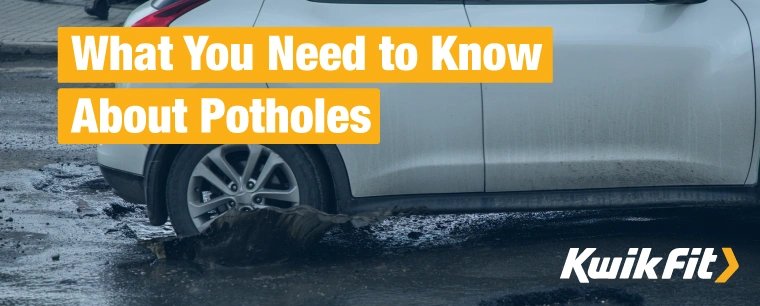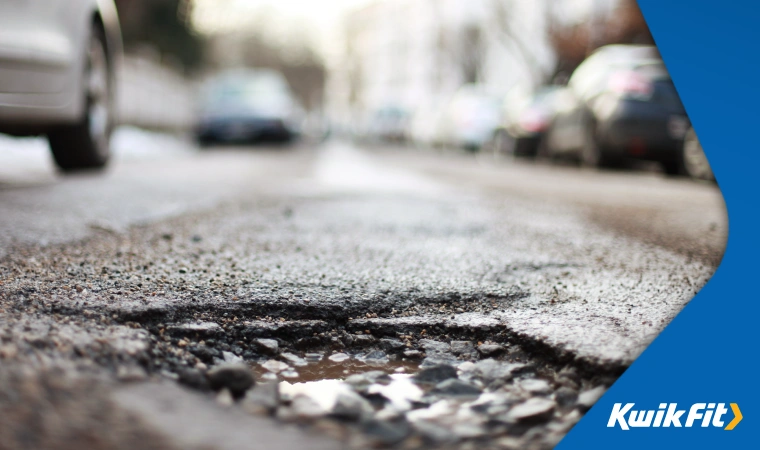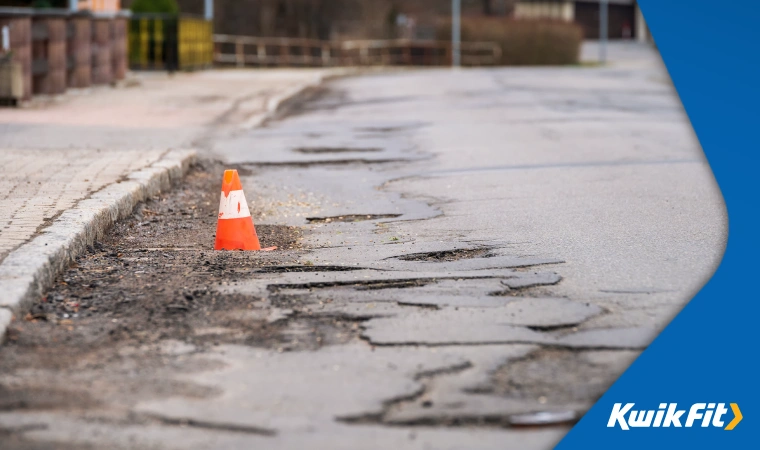What You Need to Know About Potholes
Jack Dreyer | Wednesday 12th October 2022 8:00am

For those often on the road, the year seems to cycle between potholes and roads closed for filling potholes – considering how much of a hazard they are, and how worryingly common they are, we thought we’d put together a guide.
Back in 2019, it was found that Britain had over 700,000 recorded potholes, with a combined depth of 15 times that of the Grand Canyon’s deepest point! Has anything changed now?
In this guide, you’ll learn about the formation of potholes, their effect on a road’s surface, and the dangers they can cause to your tyres. Read on for more.
How do potholes form?

The formation of potholes is usually attributed to a common form of weathering often known as ‘freeze thaw’. This is a process whereby water fills a crack, freezes, and expands – breaking up the crack a bit more. This process repeats cyclically over long periods of time to eventually wear away the surface of a road. The following steps outline this weathering process in more detail:
- The surface of the road may begin to develop cracks over time. This is natural as they are in constant use and are subject to a lot of pressure from heavy vehicles such as lorries and buses.
- Then, when it rains, water may enter these small cracks and fissures. If the weather is cold enough, and the temperatures on the road surface drop below zero, the water in these cracks may well freeze.
- When water freezes, it increases in surface area and volume by approximately 9%, making it much larger than it was before. As a result, the frozen water no longer fits comfortably into the crack.
- Due to the expansion of the water when frozen, a certain amount of pressure will now be exerted outwards onto the crack by the ice, pushing it apart wider and deepening it.
- When the temperature warms up slightly, the ice will melt and contract, leaving the crack larger. Over time, this may cause the crack to get bigger, eventually forming a pothole.
Throughout the year, this process is much more likely to occur in the Spring as this is when the temperatures fluctuate above and below freezing most frequently. The next time you’re driving in March or April, keep an eye out for more potholes than usual.
Potholes & road surfaces
Tarmac and asphalt are the most common road surfaces here in the UK and have been used as materials for roads for years now. Despite this, these substances don’t last forever and erosion and damage to our roads are inevitable.
Drive along any of the UK’s major roads and highways and you’ll see a scattering of cracks and faults here and there. But are some surfaces more pothole-prone than others? Asphalt, for example, is the most robust surface of the two. Though with a constant stream of heavy traffic, freeze-thaw weathering, excessive heat, oxidation, and factors such as leaking oil, even asphalt will weaken eventually.
How dangerous are potholes to your tyres?

Potholes are one of the most serious tyre hazards on the road and can have a significant impact on your tyre's health. On occasion, potholes can even put a tyre out of action for good. Here are just a few of the ways in which potholes can affect your tyres:
Punctures
Perhaps the most common type of tyre pothole damage is a puncture. If you drive over a pothole too quickly, the sudden impact may be enough to cause the tyre to crack, piercing the tyre, releasing air, and lowering the tyre pressure as a puncture. In this instance, you will need to replace the tyre with a newer one. You can find out how to change a tyre here.
Bulged tyres
Another result of hitting a pothole while travelling at speed is a bulge in your tyre. This is caused when the sidewall of the tyre itself gets damaged. Over time, this may lead to your tyre popping or deflating – which is never safe.
Wheel damage
Lastly, if the pothole is deep enough, your actual wheel hub may getbent or encounter damage in the form of cracking. The wheel may burst while you are driving which could send the vehicle out of control — this is why it is important to drive slowly with a steady grip on the wheel.
If you think your tyre has been affected by pothole damage, you can book in for a free tyre check at Kwik Fit. That being said, if the roads near where you live are notoriously pothole-ridden, it might be wise to look into Kwik Fit’s Tyre Care Insurance. From as little as £5.99 per tyre, your wheels will be protected from both accidental and malicious damage.
Are certain tyres better suited for roads with lots of potholes?
In terms of the type of tyres you have on your car, is there more you could be doing to arm yourself against potholes? Yes! Typically, smaller, more flimsy tyres perform less well on uneven road surfaces, whereas bigger, broader tyres are better equipped to handle the challenging terrain.
Getting your hands on a quality set of winter or all-season tyres is your best bet here.
What can you do about potholes?

Since they are often the result of natural causes, it is easy to feel powerless when it comes to potholes. But there are a number of actions you can take.
Reporting potholes
For a start, if you notice a particularly bad pothole on a road near you, you can always report it. Some county councils, like Kent, have an online reporting system where drivers can report potholes and their severity. But the government also has a centralised pothole reporting page for the entire country. If the pothole you notice is on a road managed by Highways England, however, there is another reporting process.
Avoiding potholes
As a driver, it is your responsibility to keep your car, its passengers, and its parts safe. So, to avoid pothole damage, it is often the best option to avoid potholes altogether. Here are a few tips.
Think about where you are driving and the likelihood of potholes.
On old country roads where the road surface isn’t likely to be maintained regularly (and may come under strain from agricultural vehicles), there may well be many potholes. In these areas, drive slowly and steadily.
Assume all puddles have evil intent.
Though it may well be tempting to try and wash some mud off your wheels on a rainy day by splashing through groundwater, puddles make excellent hiding spots for potholes. In fact, puddles should act as warning signs, the more puddles a road has, the more uneven its surface.
You simply can never tell just by looking at a puddle how deep or how damaged the road surface beneath it is. And it’s never worth damaging your tyres or alloys. So, if it is safe to do so, drive around it.
Maximise your visibility.
If it hasn’t been raining heavily, it is actually quite easy to play ‘pothole spotting’ if you’re paying attention. Potholes are hazards and should be given as much attention as other potential hazards on the road such as parked vehicles or obstructions.
When driving through a notoriously pothole-laden area, hang back from the car in front enough so you can see the road surface in front of you well before you encounter it. This gives you enough time to pull to the left or right to dodge a pothole, or indeed time to react if the car in front is dealt a nasty bump from a pothole.
We actually have an entirely separate blog giving you pothole avoidance tips which you can read here if you fancy it.
Reporting pothole damage
Reporting a pothole that you’ve seen and reporting pothole damage are two separate things entirely. Not all of us are lucky enough to get off scot-free from running into a pothole. If this has happened to you:
Stop where safe
Take photos
Report the pothole to authorities
Assess the damage
Carry out any repairs possible yourself
And make a claim
Here is another of our blogs which details the process of making a pothole-related claim that you may find useful.
Pothole damage? Speak to us
If you’ve recently had a nasty run-in with a pothole and you’re worried about any damage to your tyres or vehicle, pop into your local Kwik Fit and speak to the experts who can point you in the right direction.
Or, for more vehicle and tyre safety advice, head over to our blog.
Any facts, figures and prices shown in our blog articles are correct at time of publication.
Featured Articles
Is it Illegal to Drive With One Headlight?
Saturday 19th July 2025
Wondering if it’s illegal to drive with one headlight? Learn about the safety risks and penalties of illegal blown bulbs and why you should fix them promptly.
Air Con in EVs & Hybrids: Experts Answer Your Questions
Monday 30th June 2025
Does air con drain EV batteries? Can you use the air con while charging an electric car? Find out the answers to these questions & more from Kwik Fit’s experts.
Why Is Your Car Making a Noise? Fixes & Tips
Friday 13th June 2025
When your car starts making unexpected noises, it can certainly be quite disconcerting; it may be nothing to worry about, but here’s what you need to know.









